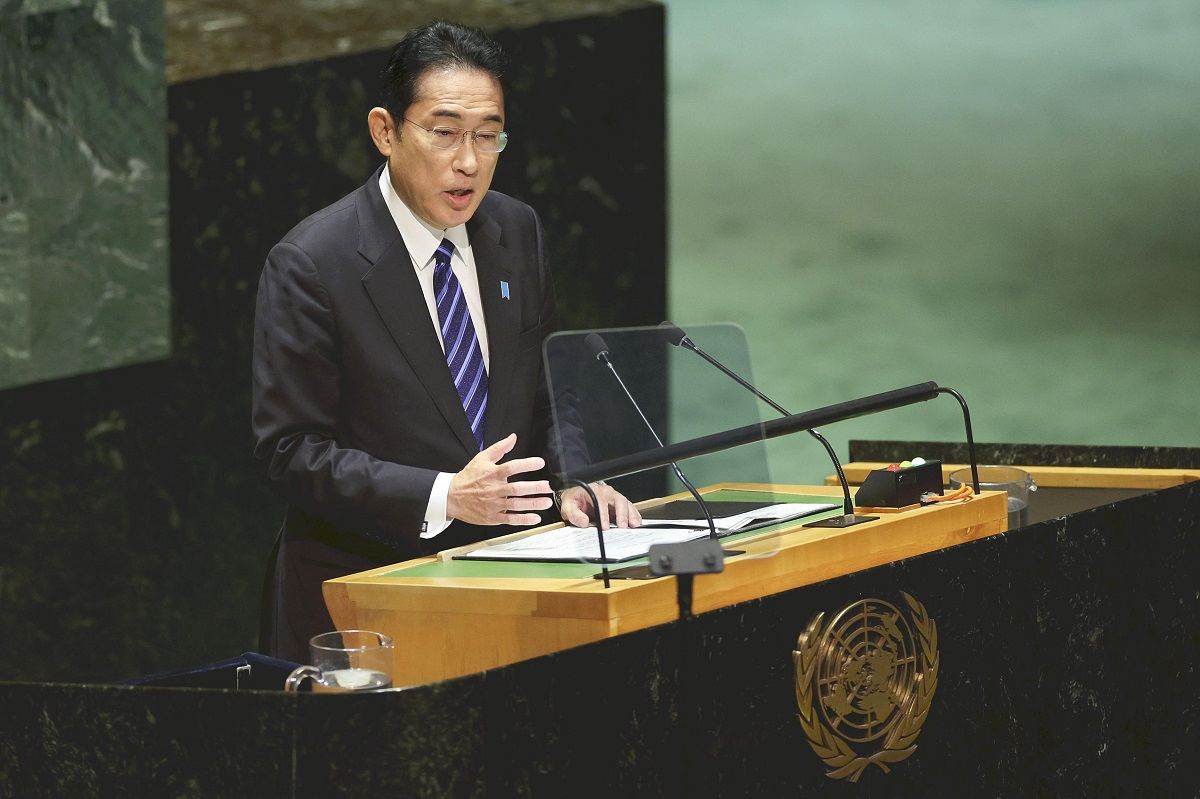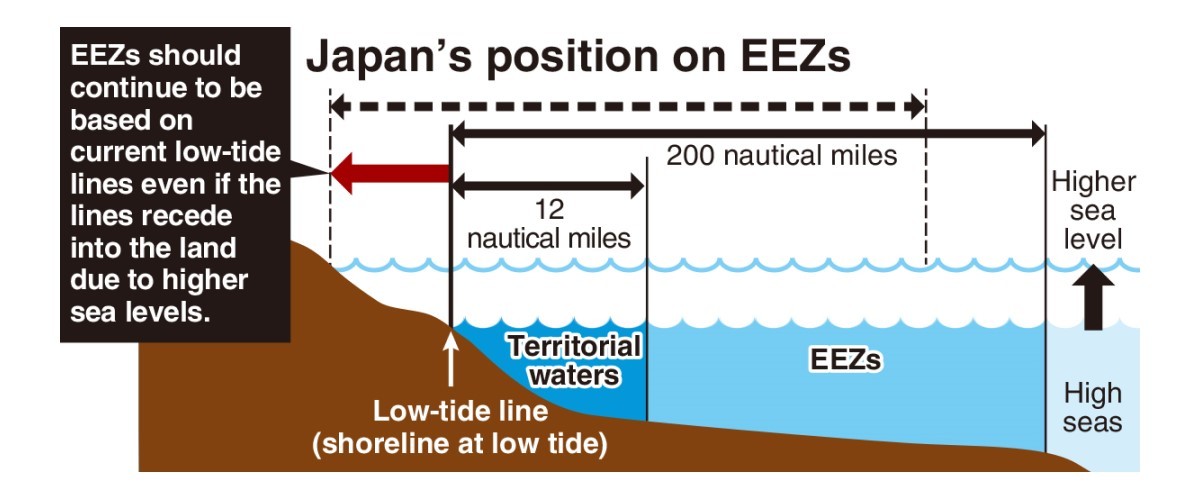Japan Seeks to Maintain Current Exclusive Economic Zones, Calls For New Interpretation of U.N. Convention

Prime Minister Fumio Kishida speaks at the U.N. General Assembly session on Sept. 19.
20:00 JST, October 3, 2023
The Japanese government has called on the international community to adopt a new interpretation of the U.N. Convention on the Law of the Sea (UNCLOS), in a bid to maintain current exclusive economic zones even if sea levels rise due to global warming.
Through its call to maintain existing low-tide lines — shorelines where the sea and land meet during low tide, the basis for EEZs — Japan apparently aims to lead the international debate on the issue and strengthen cooperation with Pacific island countries facing the threat of rising sea levels.
UNCLOS, also known as the supreme law of the sea, is an international law that serves as the basis for territorial waters, EEZs, continental shelves and other matters. It was adopted in 1982 and came into effect in 1994. As of May, it had been ratified by 168 countries, including Japan and members of the European Union.
In his speech at the U.N. General Assembly session on Sept. 19, Prime Minister Fumio Kishida said he “supports maintaining current low-tide lines based on UNCLOS even after coastlines have receded into the land due to rising sea levels.”
Kishida’s remarks suggest the issue of rising sea levels, which was not envisioned when UNCLOS was adopted, should be handled through a new interpretation of the convention. This was the first time for Kishida to mention the issue at the United Nations.
Under UNCLOS, countries that have signed the convention have exclusive rights to fish, develop natural resources and enjoy other maritime interests within their EEZs, which extend to 200 nautical miles (about 370 kilometers) from their low-tide lines.
There are no explicit provisions in the convention for situations in which coastlines recede into the land due to high sea levels, so the U.N. International Law Commission (ILC) established a working group in 2019 to begin discussions on how to deal with the issue.
If receded low-tide lines are used as the starting point of the 200 nautical miles, the areas covered by EEZs would also move landward, reducing the areas around the outer boundary of countries where they can exercise rights to fish and develop natural resources.
Conversely, if EEZs are fixed on the basis of current low-tide lines, the area of the high seas will be maintained even after sea levels rise, creating a sense of unfairness among countries seeking to expand their activities in high seas.

In February, the Japanese government for the first time compiled its view that the current low-tide lines should be used as the basis for EEZs.
Japan has the sixth-longest shoreline in the world at about 35,000 kilometers, and one of the largest EEZs. A senior Liberal Democratic Party official said making relevant preparations for rising sea levels is a “matter of vital importance” to protect maritime interests.
Japanese authorities also appear to believe that this move will promote cooperation with South Pacific island nations, which constitute a strategic stronghold where the United States and China are vying for power. Japan’s policy was conveyed to a delegation of the Pacific Islands Forum by then Foreign Minister Yoshimasa Hayashi when the delegation visited Japan in February.
The Japanese government hopes to contribute to measures against rising sea levels and fulfill the expectations of island nations. It also aims to increase the number of countries that support Japan’s policy by actively communicating it at a related U.N. meeting to be held in autumn.
“The consent of all signatories is required to establish a new interpretation of a law,” said Masahiko Asada, a professor emeritus of international law at Kyoto University and a member of the ILC. “Japan will probably aim for a unanimous resolution through meetings of signatories and other opportunities,” Asada said.
"Politics" POPULAR ARTICLE
-

Japan to Support Central Asian Logistics Route That Bypasses Russia, Plan to Be Part of Upcoming Summit in Tokyo
-

Japan to Tighten Screening of Foreigners’ Residential Status by Providing Information of Nonpayment of Taxes
-

Chinese, Russian Bombers Flew Unusual Path by Heading Toward Tokyo; Move Likely Meant to Intimidate Japan
-

Japan Plans National Database to Track Foreign Ownership of Real Estate, Land as It Weighs New Rules
-

Up to 199,000 Deaths Estimated From Mega-Tsunami; Most Recent Occurrence Took Place in 17th Century
JN ACCESS RANKING
-

Tokyo Economic Security Forum to Hold Inaugural Meeting Amid Tense Global Environment
-

Keidanren Chairman Yoshinobu Tsutsui Visits Kashiwazaki-Kariwa Nuclear Power Plant; Inspects New Emergency Safety System
-

Imports of Rare Earths from China Facing Delays, May Be Caused by Deterioration of Japan-China Relations
-

University of Tokyo Professor Discusses Japanese Economic Security in Interview Ahead of Forum
-

Japan Pulls out of Vietnam Nuclear Project, Complicating Hanoi’s Power Plans























